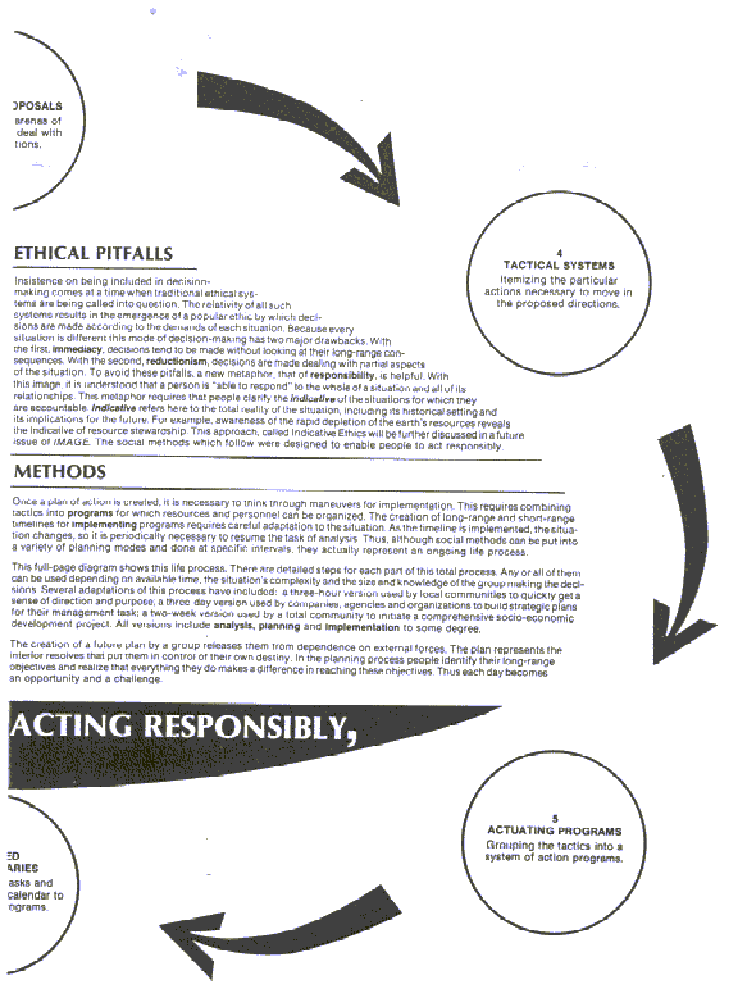


THE AWFUL SECRET OF SPIRITUALITY
The individual consciousness, precisely as a product of these fluid times, is more alive than ever and more tenuous in nature. The words used to describe feelings and values indicate the strain human consciousness is under-religion is empty and arid, art is cute and shallow, music is rock and punk, the psyche is repressed and fearful, and people are stoned and spaced out. Ira Progoff, a prominent psychologist, comments, "Today the awful secret is spirituality. Peopletodaywilldiscussanythingbuttheirinnerlife."AnaisNin, a celebrated writer, says, "The lack of intimacy with one's self, and consequently with others is what created the loneliest andmostalienatedpeople in the world. "And Karl Rahner, the German Jesuit theologian, writes, "The theologicalprob/em today is the art of drawing religion out of a man, not pumping it into him. The art is to help men become what they really are."
The theory of relativity has suddenly come of age at the most personal level. Old answers do not offer adequate responses to new questions; it isa time of opportunity, of working out new ways of dealing with ourselves, and with others. Is it any wonder that selfrealization and individual creativity have
been much soughtafter object ives of contemporary people? The diagram opposite is an attempt to graphically portray the Danish theologian Soren Kierkegaard's understanding of the "self". Put in simplified terms: people exist in relationships; they experience these relationships; they attach meanings and interpretations to these; and they make decisions about these relationships, experiences and interpretations. Becoming aware of the journey of consciousness forms the basis of the spirit methods.
Previous generations based decisions on relatively stable meanings and interpretations which today are being constantly questioned and challenged. People find themselves making decisions about ambiguous understandings; they feel sand shifting under their feet with each step they take. With increasing numbers of people asking about the meaning of life and the significance of human action, new methods for dealing with these questions are imperative. People today are faced with selfconsciously creating a story about the profound significance of their own lives in the world. In addition, they are faced with developing their own authentic lifestyle,one which is relevant, responsible and meaningful.
When selecting appropriate background music, talking over the significance of the news with a fellow commuter, writing in a daily journal, or preparing family members for an imminent death, one is using spirit methods. The term "spirit methods" is used here to refer to the method by which the deep meaning within ordinary situations can be considered. Spirit methods are at once simple yet profound. To talk of "method" in this context implies the intentional application
of a natural human process. When faced with a new situation, even when entering a room, the process any person goes through is the same: objectively, what is here? reflectively, how aoes it feel? interpretively, what does it mean for me? and decisionally, what will I do about it? This is normally unconscious and swift, but it occurs all the time.
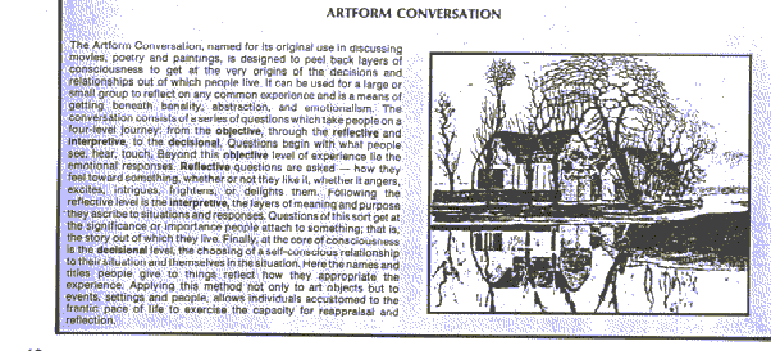
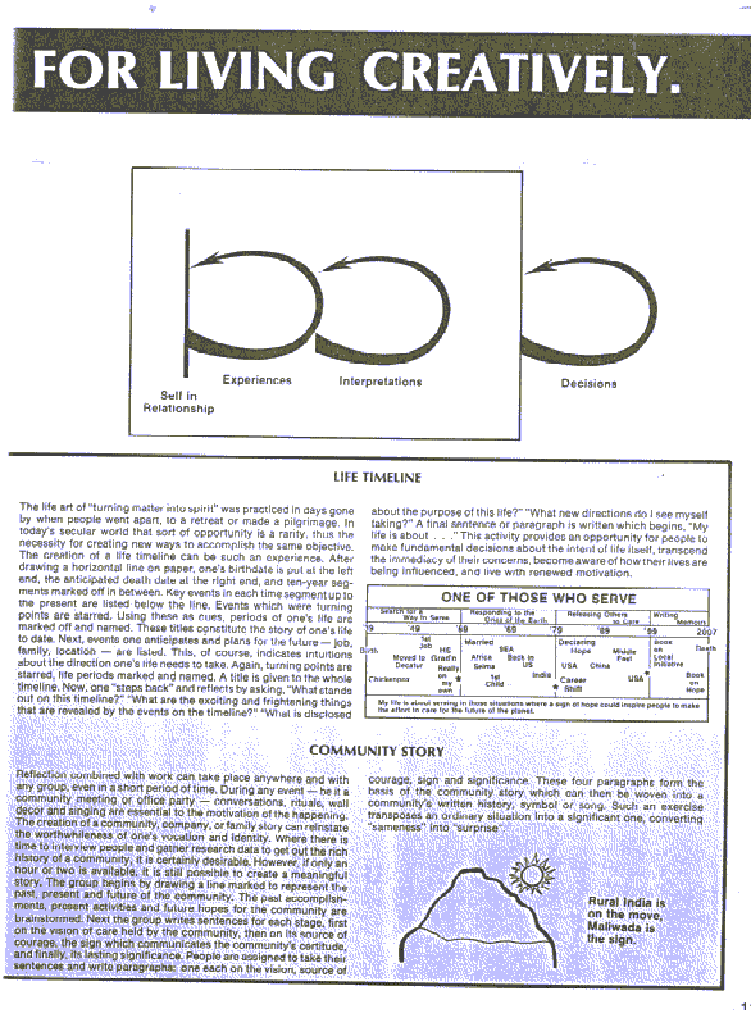
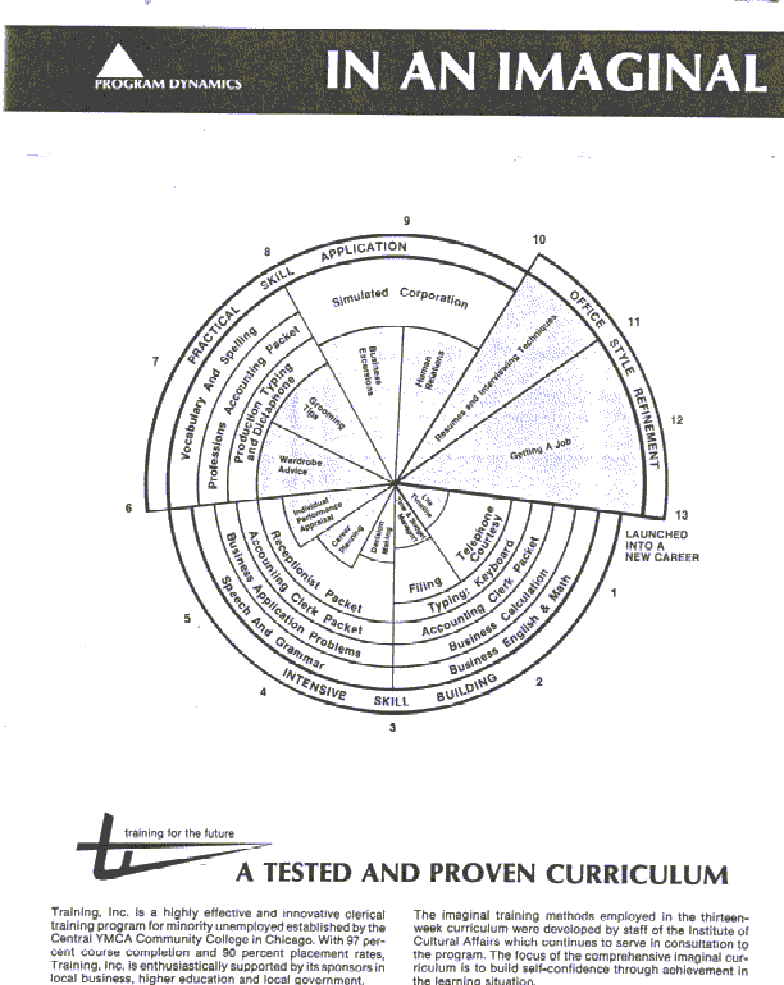

~i~m~7~

WHERE'S THE CLASSROOM?
The setting and environment of Training, Inc. is designed to educate the imagination. The program is conducted in a modern office setting located in a busy office building. Trainees do not have to wait until their training is finished to know what working in an office requires. The intentional and inviting setting assures the worth of the trainees and communicates a positive selfimage of competence, employability, and selfsufficiency. Attendance and punctuality, dress and decorum all conform to business standards. The arrangement and care of the space encourages participation and creates anticipation and excitement in the work to be done. Periodic changes in the decor and use of space bring to the trainees" attention how space effects a worker; it develops within them a sense of responsibility for their own workspace.
ANYTHING CAN HAPPEN WEDNESDAY!
The time design and program rhythm presuppose that as, Peter Drucker said, "To make a living is no longer enough. Work also has to make a life. "The rhythm of the program, and of each course, is planned to allow the possibility of releasing the depth motivity of the trainee. The stability of being present and on time for each day's class is not a common experience for these students. The reconstruction of this basic life attitude takes place on the very practical level of enabling the trainees to daily make that decision. The intentional interruption of the time schedule every Wednesday with special events and excursions allows a new relationship to be taken to what is going on in the daytoday classes. Celebrations placed periodically in the quarter's schedule shift the mood and make it possible to look at the future with anticipation. Trainees learn to enjoy the unexpected, not fear it. The invention of time as encountered in this curriculum is one of the subtle, yet most powerful, and unique features which holds trainees in the program. The possibility of designing and being in charge of time becomes one of their greatest insights from Training, Inc..
CONGRATULATIONS MARILYN JONES!
The focus of the curriculum is on the total employability of the trainee through the development of practical skills and career attitudes that enable the student to experience pride in one's work, discover the ability to be a problemsolver and embody an effective and professional business style. Students achieve by doing. They experience operating as a team, changing work roles and engaging in practical planning and selfevaluation. One of the program highlights is a twoweek total office simulation unit which integrates all components of the curriculum. The simulation calls for each trainee to assume a position in the corporation. It creates an awareness of the interrelated aspects of a business corporation and the importance of teamwork in getting the job done. Finally, in keeping with the practice of total identification with the business community, graduation for trainees of Training, Inc. takes the form of a fine business luncheon attended by program sponsors and representatives of the business community which they are about to join. The unique gifts of each graduate are celebrated and all the graduates are welcomed into the business community.
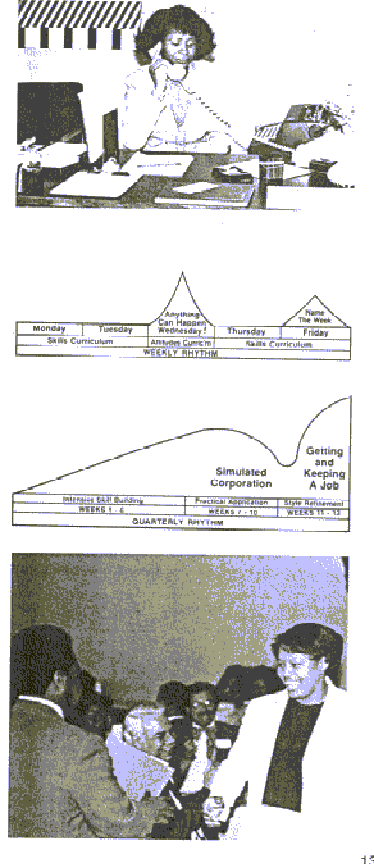
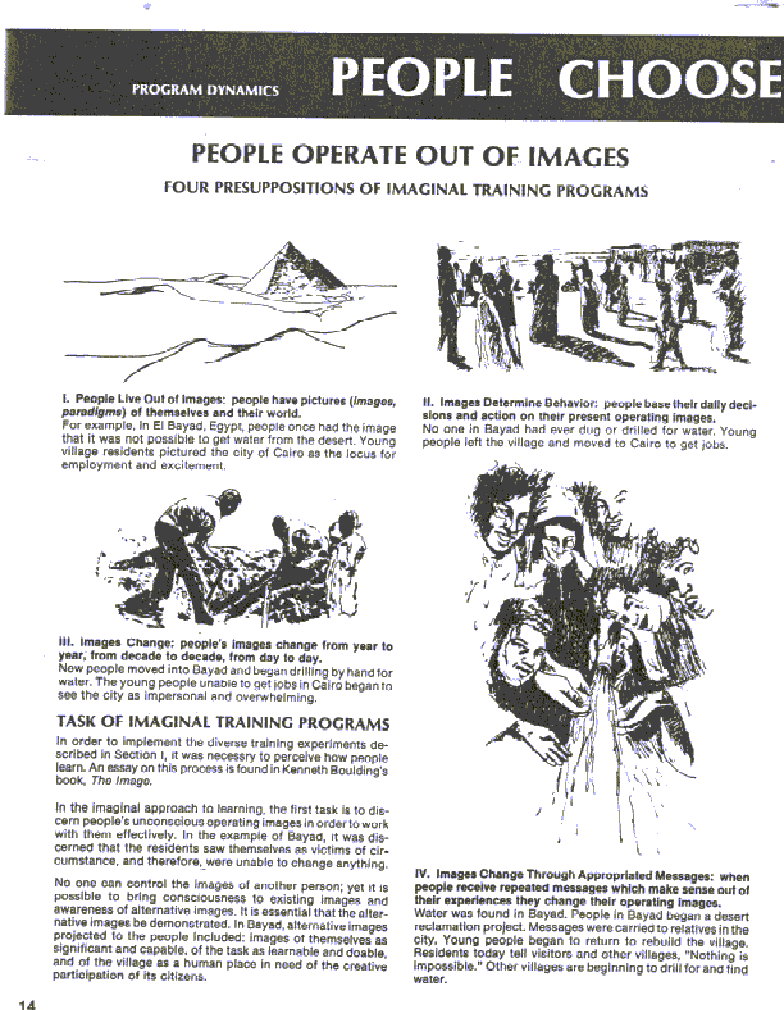

~ lzE~ Im
GUIDING THE HUMAN JOURNEY

From the moment of birth, humans embark on a lifelong journey-from one age group to another, from one decision to another, from one operating image to another. On this journey are many guides and mentors. All of us affect the journeysofthoseinourcircleofinfluence-the director of a play or corporation, fellowworkers in a laboratory or a typing pool, a sister with a brother, a mother with a daughter, members of a team, bus driver and passengers. So "you might as well be an intentional guide, because you can't avoid being a guide of some kind." Being an intentional guide involves the cultivation of four stylistic qualities: courage, care, creativity and corporateness.
COURAGE
The role of the guide requires a certain presumption, a willingness to go out on a limb to serve one's fellows. It is to acknowledge total responsibility for the wellbeing of the entire fabric of society. Mrs. Santinah is a preschool teacher in the Kelapa Dua Human Development Project in Indonesia. This 1980 quote captures her care for the community, the ambiguity involved in the decision to become a teacher and the courage inherent in enduring, day after day and year after year.
I am here In Nurada to be with my husband. My husband works In Jakarta. Out ot his lob he gets Income enough to teed my family with three children. I also recelve a stipend trom teaching In the preschool In Nurada, but that amount Is almost nothing. I teach In that preschool In tact not to get my salary.
Imagine, I only had touryears studying In Madraseh. I have never gone to primary school When the preschool In the Nurada project started In 1976, the community looked tore teacher. None of the villagers were ready. So they trled to appoint me. I frankly told them that l cannot teach. I never finished prlmary school. My neighbors and all villagers know that I am a shy woman. I cannot stand speaking In front ot crowds. How can / teach the children?
The auxillarles stopped urging me. They did not have any reason to think ol me as a candidate tor teacher. I lelt I was winning: It was success to avoid thelr Interest In me. But the community had decided to start the preschool. Already 40 children had been registered. Who will teach them?
This kind ot question pushod the auxillarles to think ot me again. They wrote a letter to me asking that questlon. Who Is supposed to teach those children? I realked that all otmy children have been In primary school. I personally will not miss that preschool It It was stopped. But have the children to be disappointed? I was contused. I could not give them a proper answer, except raising another excuse: "How can an uneducated person teach the uneducated ones? You think I who have never been In school can teach the know nothing kids? "No problem," they said. "You will be trained. The most Important thing Is you already can write the "AA" (means I can write and read the Latin alphabetical letters). Soon atter that I was trained and started teaching until now. I have become tamillar with that lob. not trembilan AnvmnrA u/,_ J^.., .,A~
CARE
Guiding people on a journey requires that one map out that journey: first the anticipated results of the journey are determined. Then the guide discerns the necessary experiences along the way. the objective charting of this journey requires great sensitivity. Careful, continuous review of where people are on the journey is critical. For example, in a program like the Human Development Training Institute in India, each participant's response is reviewed weekly by the staff. Experience in many such reviewing sessions has led to the following observation:
One can see the purney In consciousness and In seltlmage ot many ot the students as they progress trom thelr first days In the school, timid and disoriented, through thelr trip to Bombay or another city, to emerge as those responsible tor belag the agents ot change In villages other than thelr own.

CREATIVITY
Being an intentional guide means enabling people to experience the journey they are on and to reflect on it. It means daring to examine your own life experience, to see through it to the universal human experience, and to creatively use it for the sake of others. This can be done by bringing consciousness to human experiences through structuring situations and programs which can catalyze such consciousness. One example is the structured entrance into the Student House program.
The Student House program tor boys and girls aged 1214 Is a twoyear residential experience. It Is a segment of the lltelong purney within a complex of human relationships and covenants. Durlng the summer atter completing the sixth grade and prior to entering the Student House, the students participate In a riteotpassage trek. Combining aspects ota survival trip and a mythological Journey, the trek symbolizes the end ot childhood and the beginning ot the purney towards adulthood. This sending out trom the parents and rite ot passage are not Imposed on llte but dramatize the actual death ot childhood, the birth ot a new human person and the drive tor seltdeterminatlon which occurs In the llte ot every child about the age ot 12.
CORPORATENESS
The responsibility of the guide is to clarify the broader sociological journey of which all are a part. It is to exemplify the action for which the times are calling and to require the responses upon which the future of society depends. In our day, when teamwork is one of these requirements, the role of the guide can be most effectively performed by a team. The Global Academy is an eightweek methods training program which serves as the laboratory for new imaginal training methods. An evaluatorparticipant of the Academy observed the following:
Underlying the carefully constructed curriculum Is the team approach ot the stats. The entire stats adopts the same approach to the students, and Is supportive ot each Instructor's stance. Each member ot the stats Is tamillar with the entire curriculum and Is prepared to shift roles when needed. More Is learned trom the wev
i ~
.-
~w


ANYTHING CAN BE TAUGHT TO ANYONE
Not only must a curriculum emphasize methodology and wholeness but it must also be dynamic. It must be adaptable to different age groups, different communities and the relentless process of historical change. The work on curriculum designs for Imaginal Training Programs was partly influenced by the thinking of Jerome Bruner, held in this quote from The Process of Education, "Anything can be taught to anyone at any age as long as it is taught in his worldview and with his language."
Learning is a cradletograve experience. The fact that this experience is an everwidening and deepening process has led to the use of the image of a spiral curriculum as displayed in the diagram to the right. The diagram shows that the same curriculum concepts are repeated in a rational pattern. With each repetition, the curriculum increases in complexity and challenge, incorporating the most recent wisdom, and eliciting deeper levels of response. Having laid foundations in the childhood years, the curriculum broadens in scope to correspond with the broadened capacities of the child. The curriculum emphasis continues to shift in adulthood according to the demands of vocation and responsibility.
TWO REFERENCE POINTS
Thus, as the diagram indicates, there are two reference points to be used in building curriculum: continuity of concepts through time and comprehensiveness In the curriculum at any point In tlme.
Continulty of concept can be illustrated by taking a vertica/ cross section of the spiral. At any point the cross section would reveal a basic concept being taught across the ages (infants through adults), utilizing time, space, content and methods designed to meet the individual's stage of development and perception of life.
A concept such as Newton's third law of motion, "To every action there is always opposed an equal reaction," can be demonstrated to two year olds simply by releasing an inflated balloon. Eightytwo year olds, on the other hand, might be more interested in the implications for walking on icy sidewalks. An appropriate illustration in an Indonesian fishing village might be mechanics of rowing an empty boat or one full of fish. A college student, however, may need to study by charting Book 1: The Motion of Bodies in Isaac Newton's Mathematical Principles of Natural Philosophy. Each group has its own images and experience of life, hence the actual curriculum in both content and method is subject to infinite variation. Similarly, the curriculum will be different ten years from now in its specific materials, but the realities dealt with by physics, or any other discipline, will not change.
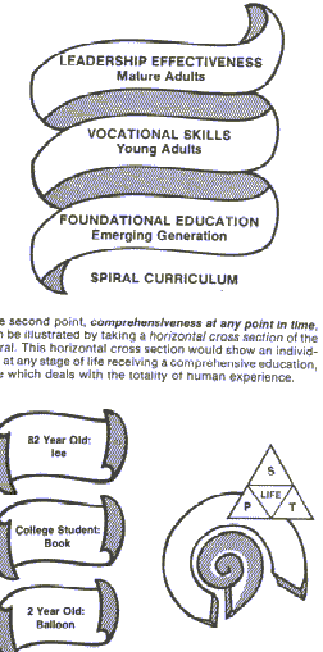
The Institutes look upon the last 30 years of experience in Imaginal Education as a great resource for creating the Future. At this time work is in progress to draw out of the multiplicity of experiments relevant new patterns for a cohe
THE FUTURE TASK
sive lifelong curriculum. Such a cohesive spiral is a basic necessity in being able to meet the worldwide demand for education. Before massive delivery can happen, what is to be delivered must be clarified.

IMAGE is a quarterly publication prepared by the research staffs of The Ecumenical Institute and The Institute of Cultural Affairs. The purpose of the publication is to share research, training and demonstration methods developed over the last quarter century. IMAGE, formerly a journal of The Ecumenical Institute, is now published under the auspices of The Institute of Cultural Affairs. The next issue of IMAGEwill feature Demonstration Methods.
The Institute of Cultural Affairs is a research, training and demonstration group concerned with the human factor in world development. Private and voluntary in nature, the ICA has offices in 32 nations and operates as a notforprofit, intraglobal organization. The ICA originally operated as a program division of The Ecumenical Institute, a center for practical theological education. In 1973 the ICA was incorporated as a separate entity to better serve local communities around the world.
For subscription inquiries write: IMAGE, ICA,4750North Subscription rate: $12.00 per year in USA. Single copy
Sheridan Road, Chicago, Illinois 60640,
U.S.A. price: $3.50.
